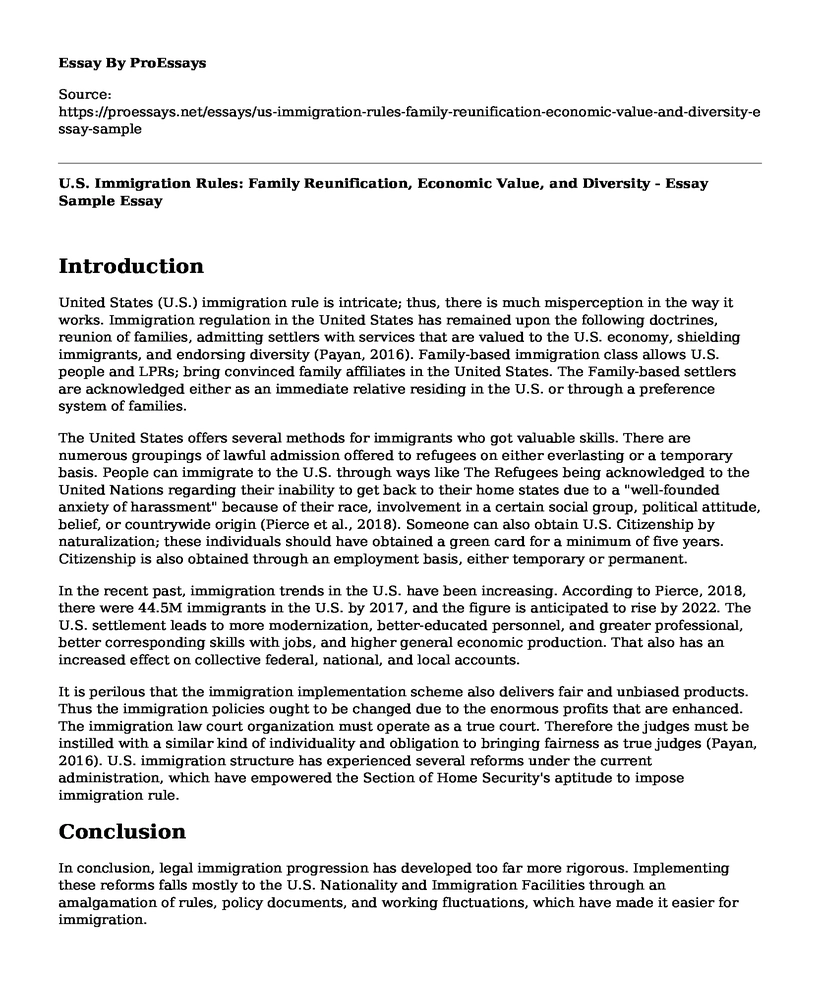Introduction
United States (U.S.) immigration rule is intricate; thus, there is much misperception in the way it works. Immigration regulation in the United States has remained upon the following doctrines, reunion of families, admitting settlers with services that are valued to the U.S. economy, shielding immigrants, and endorsing diversity (Payan, 2016). Family-based immigration class allows U.S. people and LPRs; bring convinced family affiliates in the United States. The Family-based settlers are acknowledged either as an immediate relative residing in the U.S. or through a preference system of families.
The United States offers several methods for immigrants who got valuable skills. There are numerous groupings of lawful admission offered to refugees on either everlasting or a temporary basis. People can immigrate to the U.S. through ways like The Refugees being acknowledged to the United Nations regarding their inability to get back to their home states due to a "well-founded anxiety of harassment" because of their race, involvement in a certain social group, political attitude, belief, or countrywide origin (Pierce et al., 2018). Someone can also obtain U.S. Citizenship by naturalization; these individuals should have obtained a green card for a minimum of five years. Citizenship is also obtained through an employment basis, either temporary or permanent.
In the recent past, immigration trends in the U.S. have been increasing. According to Pierce, 2018, there were 44.5M immigrants in the U.S. by 2017, and the figure is anticipated to rise by 2022. The U.S. settlement leads to more modernization, better-educated personnel, and greater professional, better corresponding skills with jobs, and higher general economic production. That also has an increased effect on collective federal, national, and local accounts.
It is perilous that the immigration implementation scheme also delivers fair and unbiased products. Thus the immigration policies ought to be changed due to the enormous profits that are enhanced. The immigration law court organization must operate as a true court. Therefore the judges must be instilled with a similar kind of individuality and obligation to bringing fairness as true judges (Payan, 2016). U.S. immigration structure has experienced several reforms under the current administration, which have empowered the Section of Home Security's aptitude to impose immigration rule.
Conclusion
In conclusion, legal immigration progression has developed too far more rigorous. Implementing these reforms falls mostly to the U.S. Nationality and Immigration Facilities through an amalgamation of rules, policy documents, and working fluctuations, which have made it easier for immigration.
References
Payan, T. (2016). Immigration and the United States: A Path to Resolution. Policy Brief: Recommendations for the New Administration.
Pierce, S., Bolter, J., & Selee, A. (2018). U.S. immigration policy under Trump: Deep Changes and lasting impacts. Migration Policy Institute, 9.
Cite this page
U.S. Immigration Rules: Family Reunification, Economic Value, and Diversity - Essay Sample. (2023, Mar 29). Retrieved from https://proessays.net/essays/us-immigration-rules-family-reunification-economic-value-and-diversity-essay-sample
If you are the original author of this essay and no longer wish to have it published on the ProEssays website, please click below to request its removal:
- Research Paper on Organized Crime
- Social Determinants of Health in Violence Against Essay
- Essay Sample on Sexual Addiction: A Complexity of Human Sexual Behaviour
- Domestic Violence: A Deep-Rooted Historical Problem Now in Focus - Essay Sample
- Women's Fight for Equality: A Historical Overview - Research Paper
- Essay Example on Abortion Debate: Pro-Choice and Pro-Life Views in 2021
- Quebec Immigration - Report Example







